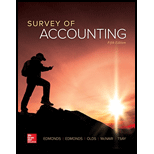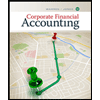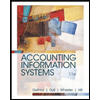
Louise Stinson, the chief financial officer of Bostonian Corporation, was on her way to the president’s office. She was carrying the latest round of bad news. There would be no executive bonuses this year. Corporate profits were down. Indeed, if the latest projections held true, the company would report a small loss on the year-end income statement. Executive bonuses were tied to corporate profits. The executive compensation plan provided for 10 percent of net earnings to be set aside for bonuses. No profits meant no bonuses. While things looked bleak, Stinson had a plan that might help soften the blow.
After informing the company president of the earnings
Some of the other items that Stinson is considering include (1) converting from straight-line to accelerated
Required
- a. Explain how each of the three numbered strategies for increasing the amount of the current year's loss would affect the stockholders’ equity section of the
balance sheet in the current year. How would the other elements of the balance sheet be affected? - b. If Stinson's strategy were effectively implemented, how would it affect the stockholders’ equity in subsequent accounting periods?
- c. Comment on the ethical implications of running the company for the sake of management (maximization of bonuses) versus the maximization of return to stockholders.
- d. Formulate a bonus plan that will motivate managers to maximize the value of the firm instead of motivating them to manipulate the reporting process.
- e. How would Stinson's strategy of overstating the amount of the reported loss in the current year affect the company’s current P/E ratio?
Want to see the full answer?
Check out a sample textbook solution
Chapter 8 Solutions
Survey Of Accounting
- Ethics and professional conduct in business Tonya Latirno is a certified public accountant (CPA) and staff accountant for Kennedy and Kennedy, a local CPA firm. It had been the policy of the firm to provide a holiday bonus equal to two weeks salary to all employees. The firms new management team announced on November 15 that a bonus equal to only one weeks salary would be made available to employees this year. Tonya thought that this policy was unfair because she and her coworkers planned on the full two-week bonus. The two-week bonus had been given for 10 straight years, so it seemed as though the firm had breached an implied commitment. Thus, Tonya decided that she would make up the lost bonus week by working an extra six hours of overtime per week over the next five weeks until the end of the year. Kennedy and Kennedys policy is to pay overtime at 150% of straight time. Tonyas supervisor was surprised to see overtime being reported, because there is generally very little additional or unusual client service demands at the end of the calendar year. However, the overtime was not questioned, because firm employees are on the honor system in reporting their overtime. Discuss whether the firm is acting in an ethical manner by changing the bonus. Is Tonya behaving in an ethical manner?arrow_forwardEthics and professional conduct in business The director of marketing for Truss Industries Inc.. Ellen Knutson, had the following discussion with the company controller. Bud Wyckoff. on February 26 of the current year: Ellen: Bud, it looks like I'm going to spend much less than indicated on my February budget. Butt: I'm glad to hear it. Ellen: Well. I'm not so sure it's good news. I'm concerned that the president will see that I'm under budget and reduce my budget in the future. The only reason that I look good is that we've delayed an advertising campaign. Once the campaign hits in May. I'm sure my actual expenditures will go up. You see. we are also having our sales convention in May. Having the advertising campaign and the convention at the same time is going to kill my May numbers.arrow_forwardProblem 9-24 (LO. 3) Kristen, an independent management consultant, is based in Atlanta. During March and April of 2020, she is contracted by a national hardware chain to help implement revised human resource policies in Jackson (Mississippi) temporarily. During this period, Kristen flies to Jackson on Sunday night, spends the week at the district office, and returns home to Atlanta on Friday afternoon. The cost of returning home is $550, and the cost of spending the weekend in Jackson would have been $490. a. Presuming no reimbursement for these expenses, how much, if any, of these weekend expenses may Kristen deduct?$fill in the blank 9570f9fe1fa5079_1 b. What would your answer be if the amounts involved were reversed (i.e., the trip home would have cost $490; staying in Jackson would have been $550)? Kristen may deduct $fill in the blank 05a4acfc8fd204e_1 as weekend expenses.arrow_forward
 Survey of Accounting (Accounting I)AccountingISBN:9781305961883Author:Carl WarrenPublisher:Cengage Learning
Survey of Accounting (Accounting I)AccountingISBN:9781305961883Author:Carl WarrenPublisher:Cengage Learning Accounting (Text Only)AccountingISBN:9781285743615Author:Carl Warren, James M. Reeve, Jonathan DuchacPublisher:Cengage Learning
Accounting (Text Only)AccountingISBN:9781285743615Author:Carl Warren, James M. Reeve, Jonathan DuchacPublisher:Cengage Learning Financial & Managerial AccountingAccountingISBN:9781285866307Author:Carl Warren, James M. Reeve, Jonathan DuchacPublisher:Cengage Learning
Financial & Managerial AccountingAccountingISBN:9781285866307Author:Carl Warren, James M. Reeve, Jonathan DuchacPublisher:Cengage Learning Corporate Financial AccountingAccountingISBN:9781337398169Author:Carl Warren, Jeff JonesPublisher:Cengage Learning
Corporate Financial AccountingAccountingISBN:9781337398169Author:Carl Warren, Jeff JonesPublisher:Cengage Learning AccountingAccountingISBN:9781337272094Author:WARREN, Carl S., Reeve, James M., Duchac, Jonathan E.Publisher:Cengage Learning,
AccountingAccountingISBN:9781337272094Author:WARREN, Carl S., Reeve, James M., Duchac, Jonathan E.Publisher:Cengage Learning, Accounting Information SystemsFinanceISBN:9781337552127Author:Ulric J. Gelinas, Richard B. Dull, Patrick Wheeler, Mary Callahan HillPublisher:Cengage Learning
Accounting Information SystemsFinanceISBN:9781337552127Author:Ulric J. Gelinas, Richard B. Dull, Patrick Wheeler, Mary Callahan HillPublisher:Cengage Learning





